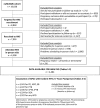Association of Adverse Pregnancy Outcomes With Hypertension 2 to 7 Years Postpartum
- PMID: 31564189
- PMCID: PMC6806043
- DOI: 10.1161/JAHA.119.013092
Association of Adverse Pregnancy Outcomes With Hypertension 2 to 7 Years Postpartum
Abstract
Background Identifying pregnancy-associated risk factors before the development of major cardiovascular disease events could provide opportunities for prevention. The objective of this study was to determine the association between outcomes in first pregnancies and subsequent cardiovascular health. Methods and Results The Nulliparous Pregnancy Outcomes Study Monitoring Mothers-to-be Heart Health Study is a prospective observational cohort that followed 4484 women 2 to 7 years (mean 3.2 years) after their first pregnancy. Adverse pregnancy outcomes (defined as hypertensive disorders of pregnancy, small-for-gestational-age birth, preterm birth, and stillbirth) were identified prospectively in 1017 of the women (22.7%) during this pregnancy. The primary outcome was incident hypertension (HTN). Women without adverse pregnancy outcomes served as controls. Risk ratios (RR) and 95% CIs were adjusted for age, smoking, body mass index, insurance type, and race/ethnicity at enrollment during pregnancy. The overall incidence of HTN was 5.4% (95% CI 4.7% to 6.1%). Women with adverse pregnancy outcomes had higher adjusted risk of HTN at follow-up compared with controls (RR 2.4, 95% CI 1.8-3.1). The association held for individual adverse pregnancy outcomes: any hypertensive disorders of pregnancy (RR 2.7, 95% CI 2.0-3.6), preeclampsia (RR 2.8, 95% CI 2.0-4.0), and preterm birth (RR 2.7, 95% CI 1.9-3.8). Women who had an indicated preterm birth and hypertensive disorders of pregnancy had the highest risk of HTN (RR 4.3, 95% CI 2.7-6.7). Conclusions Several pregnancy complications in the first pregnancy are associated with development of HTN 2 to 7 years later. Preventive care for women should include a detailed pregnancy history to aid in counseling about HTN risk. Clinical Trial Registration URL: http://www.clinicaltrials.gov Unique identifier: NCT02231398.
Keywords: adverse pregnancy outcomes; hypertension; preeclampsia; preterm birth; risk.
Figures

References
-
- Benjamin EJ, Virani SS, Callaway CW, Chamberlain AM, Chang AR, Cheng S, Chiuve SE, Cushman M, Delling FN, Deo R, de Ferranti SD, Ferguson JF, Fornage M, Gillespie C, Isasi CR, Jimenez MC, Jordan LC, Judd SE, Lackland D, Lichtman JH, Lisabeth L, Liu S, Longenecker CT, Lutsey PL, Mackey JS, Matchar DB, Matsushita K, Mussolino ME, Nasir K, O'Flaherty M, Palaniappan LP, Pandey A, Pandey DK, Reeves MJ, Ritchey MD, Rodriguez CJ, Roth GA, Rosamond WD, Sampson UKA, Satou GM, Shah SH, Spartano NL, Tirschwell DL, Tsao CW, Voeks JH, Willey JZ, Wilkins JT, Wu JH, Alger HM, Wong SS, Muntner P; American Heart Association Council on Epidemiology and Prevention Statistics Committee and Stroke Statistics Subcommittee . Heart disease and stroke statistics—2018 update: a report from the American Heart Association. Circulation. 2018;137:e67–e492. - PubMed
-
- Folsom AR, Kaye SA, Sellers TA, Hong CP, Cerhan JR, Potter JD, Prineas RJ. Body fat distribution and 5‐year risk of death in older women. JAMA. 1993;269:483–487. - PubMed
-
- Gordon T, Castelli WP, Hjortland MC, Kannel WB, Dawber TR. Diabetes, blood lipids, and the role of obesity in coronary heart disease risk for women. The Framingham Study. Ann Intern Med. 1977;87:393–397. - PubMed
-
- Manson JE, Colditz GA, Stampfer MJ, Willett WC, Rosner B, Monson RR, Speizer FE, Hennekens CH. A prospective study of obesity and risk of coronary heart disease in women. N Engl J Med. 1990;322:882–889. - PubMed
Publication types
MeSH terms
Associated data
Grants and funding
- U10 HL120006/HL/NHLBI NIH HHS/United States
- U10 HL119991/HL/NHLBI NIH HHS/United States
- UL1 TR000124/TR/NCATS NIH HHS/United States
- UL1 TR000439/TR/NCATS NIH HHS/United States
- UL1 TR000153/TR/NCATS NIH HHS/United States
- U10 HL119993/HL/NHLBI NIH HHS/United States
- U10 HL119992/HL/NHLBI NIH HHS/United States
- U10 HL120019/HL/NHLBI NIH HHS/United States
- UL1 TR002548/TR/NCATS NIH HHS/United States
- U10 HL119989/HL/NHLBI NIH HHS/United States
- UL1 TR001863/TR/NCATS NIH HHS/United States
- U10 HL120018/HL/NHLBI NIH HHS/United States
- U10 HL119990/HL/NHLBI NIH HHS/United States
- UL1 TR001108/TR/NCATS NIH HHS/United States
- UL1 TR001881/TR/NCATS NIH HHS/United States
- U10 HL120034/HL/NHLBI NIH HHS/United States

